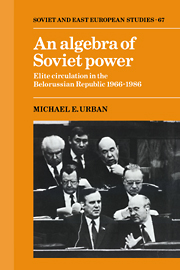Book contents
- Frontmatter
- Contents
- List of figures and tables
- Preface
- Acknowledgements
- 1 Method, model and historical background
- 2 Hierarchy, mobility and a stratified model
- 3 Centralization as a determinant of elite circulation
- 4 The regional structure of elite circulation
- 5 The structure of patronage affiliations
- 6 Does faction make a difference?
- 7 Political succession
- 8 Conclusions, implications and the question of levels
- Appendix A Stratification of positions in the Belorussian Republic, 1966–86
- Appendix B A roster of factional groups in the Belorussian Republic, 1966–86
- Notes
- Index
- Soviet and East European Studies
1 - Method, model and historical background
Published online by Cambridge University Press: 09 November 2009
- Frontmatter
- Contents
- List of figures and tables
- Preface
- Acknowledgements
- 1 Method, model and historical background
- 2 Hierarchy, mobility and a stratified model
- 3 Centralization as a determinant of elite circulation
- 4 The regional structure of elite circulation
- 5 The structure of patronage affiliations
- 6 Does faction make a difference?
- 7 Political succession
- 8 Conclusions, implications and the question of levels
- Appendix A Stratification of positions in the Belorussian Republic, 1966–86
- Appendix B A roster of factional groups in the Belorussian Republic, 1966–86
- Notes
- Index
- Soviet and East European Studies
Summary
This chapter aims to locate the method, model and object of this study within the field of research devoted to the analysis of Soviet political elites. The first section examines the matter of setting or context with a basic theoretical question in mind; namely, how might we conceptualize the set of sociopolitical relations extant in the USSR which both defines the system's elite(s) and structures their activity? Here, our concern is to probe the characteristics of the Soviet form of organization and, in so doing, to highlight some of the issues associated with elite analysis in the Soviet case.
The second section covers much the same ground from a methodological perspective. It presents an outline of the method and model heretofore employed in Soviet elite studies, and argues that the conventional approach, which focuses on individual actors and their attributes, is hampered by some important limitations on the questions that it can pose and the conclusions that it can reasonably draw. In order to overcome these shortcomings, a method is introduced which directly incorporates into the analysis the relations among actors in the system as they circulate through the array of elite positions. This method, vacancy chain analysis, and a revised model for the study of Soviet elites are then explicated in some detail.
Finally, the third section places the object of our study, political elites in the Belorussian Soviet Socialist Republic (BSSR), in an historical perspective. It takes up those national, socioeconomic and political features of Belorussia's development which bear upon the empirical analysis of elites in the contemporary BSSR.
- Type
- Chapter
- Information
- An Algebra of Soviet PowerElite Circulation in the Belorussian Republic 1966–86, pp. 1 - 17Publisher: Cambridge University PressPrint publication year: 1989



